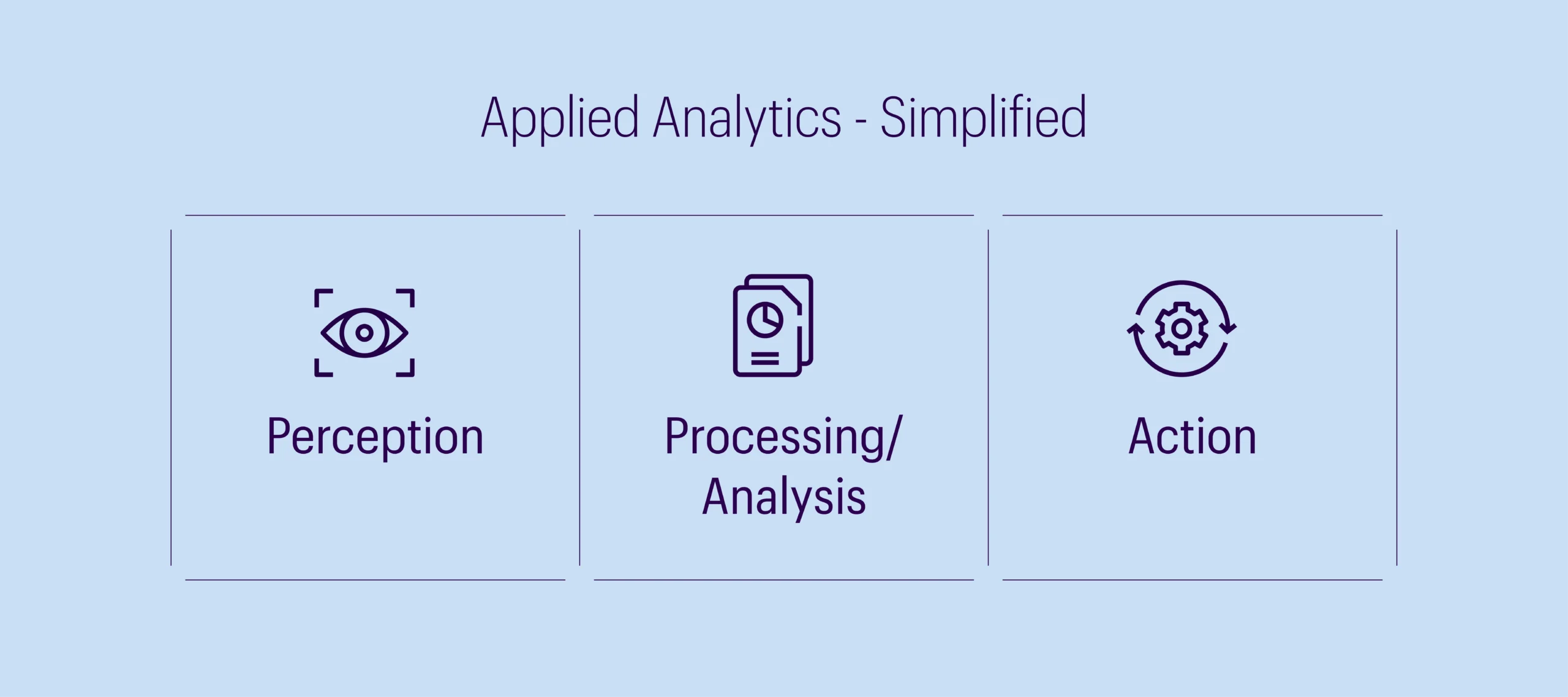The Analytics Revolution is here to stay. The internet, personal computers, internal combustion engines and telephones have fundamentally changed the way we live and work. Analytics clearly, is the next big thing. If you went off on a tour of the galaxy in 2010 and returned in 2020, you would see a completely different way of life on earth, predominantly enabled by Analytics. In this multi-part series, we will explore all aspects of analytical transformation from scratch, so it serves as a handy guide for executives. Let’s start with the basics.
So, what is this beast?
Since the intended audience here is senior executives, we take a very broad perspective of the field of Analytics. Analytics and AI broadly refer to all the capabilities that help an organization emulate the activities of human beings, using technology, data and ‘intelligence’. There are three major groups of activities in this regard – Perception, Processing and Action. (The fourth broad group of activity that human beings carry out in organizations is insight generation and decision making through gut feel, data, creativity and imagination. This activity is largely beyond the capability of today’s machines, except in specific cases.)

Perception:
Through a combination of advances in the Internet of Things and related technologies, computers can fairly emulate what our sense organs can do – recognize images and motion through video & image analytics, recognize and make sense of voice, perceive the right combination of touch (or pressure), heat, velocity, sense danger in the surrounding environment etc. Individually or collectively, these technologies and techniques help ‘perceive’ external or internal environments and transmit them in human-readable form or take them further for analysis by computers.
Processing / Analysis:
As far as the transmission of signals goes, human or machine-readable signals are useful. Combining these signals with other forms of data, processing them and offering insights makes these signals exponentially more useful. This ability of our programs to process large amounts of data coming from humans, machines or databases and offer useful insights is the most popular form of Analytics we know today. For example, when you open your favourite map on the phone, it shows your current location. That’s perception. When you key-in your desired destination it shows you the fastest route and estimated time to reach there. That’s processing or analysis. In a manufacturing setup, the ability to assess the current levels of temperature, pressure, vibration and sound is perception. Analysing the combination of these variables, comparing with past information, and determining that the machine will fail in the next two hours, is processing.
Action:
Action is what human arms and legs can do. Empowered by advances in robotic technology and AI, machines can do both physical and software tasks that humans perform, from operating machines to moving things from point A to point B, sending routine emails, creating business reports, and booking your doctor’s appointment. Large logistics operation wings, such as ones in Amazon, are already using robot and AI-enabled machines to work as warehouse personnel, receive and place items in appropriate locations, and fetch them when required.
A combination of perception, processing and action has made analytics (along with peripheral technologies like IOT, robotics, etc.) a formidable tool that would augment or replace human effort in every form. This will fundamentally shift the way organizations work, changing the very nature of competition in most industries.
Why today?
Five enablers have come together to make analytics a force to reckon with. They include the explosion of data sources, rapid, democratic expansion in computer science research resulting in sophisticated algorithms, compounded effect of Moore’s Law resulting in previously unimaginable processing speed, continuous improvement in cost-effective data storage, and broad advances in peripheral sciences and technologies like IOT, robotics, nanotechnology, metallurgy, etc. With this, we can procure, store and process humongous amounts of data at lightning speed, generating insights and enabling both humans and machines to take multiple informed decisions faster than ever before, and act almost in real-time.
So what?
The advances in analytics are causing similar tectonic shifts in the nature of work that electricity, personal computers and the internet had caused a few decades ago, but at a much larger scale. Every repeatable process is being automated, even in places where a certain amount of judgement is involved. All actions that can be codified are being codified (think of Netflix’s recommendation system showing hyper-personalized recommendations to a million users in parallel).
This is resulting in a fundamental change in business models. Before the advent of analytics, organizations were delivering products and competition was based on who can deliver a better or niche product. Today, powered by analytics and technology, organizations compete for outcomes, and the competition is based on who can understand the customer’s unstated needs and deliver a better outcome. This fundamental change in the nature of competition will require every organization to reinvent its business model and what it delivers. Every organization will need to identify its key strengths and cultural foundations and take its unique transformation journey so an analytically-enabled version of itself emerges, ready to compete in a world of new realities.
Stay tuned for the next part of this series, where we will explore – how you can get your analytics transformation right.